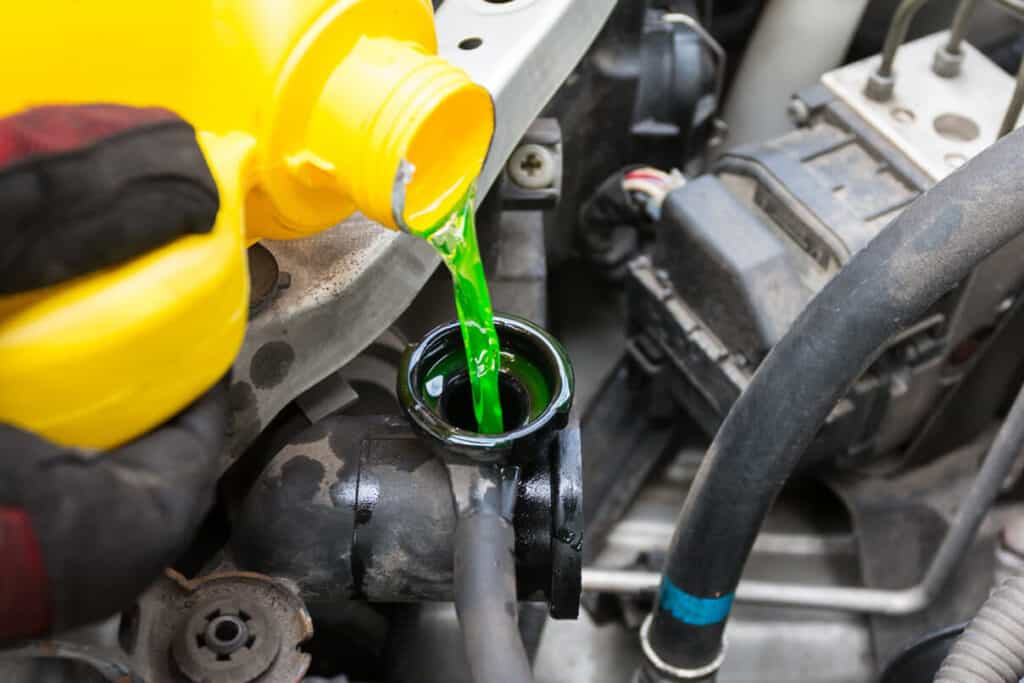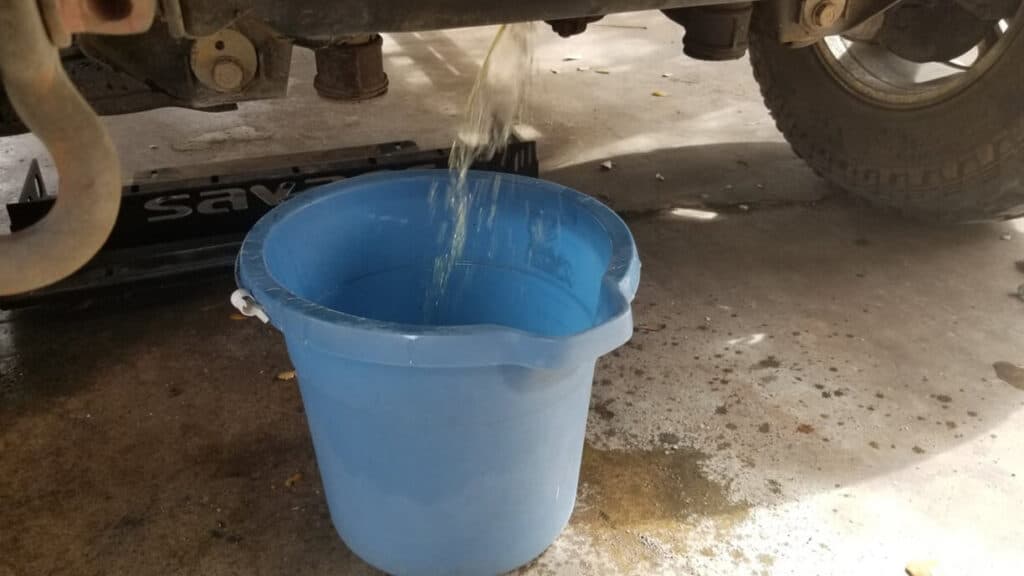What is a Coolant Flush?
We’re all familiar with the need to change our car’s oil, but there’s another vital fluid that requires regular attention – the coolant. A coolant flush, also known as a radiator flush, is a process that involves draining the existing coolant from your vehicle’s radiator and replacing it with fresh, clean coolant. This process is crucial to maintain the health of your vehicle’s cooling system, preventing overheating and potential severe engine damage.
How Much Will it Cost to Perform a Coolant Flush in Canada?
Coolant flush costs in Canada can range widely, typically sitting between $100-$150 CAD. The variance is due to factors such as your vehicle’s make and model, the price of the coolant used, and labour costs. Labour rates can range from $50-$120 CAD per hour, and a typical coolant flush will take about 1-2 hours to complete. Keep in mind; prices will vary between different regions and shops.

What are the Symptoms of Contaminated or Old Coolant?
Watch out for these signs that your coolant may be contaminated or old:
• Overheating Engine: Contaminated or old coolant might not be effective in regulating engine temperature, leading to frequent overheating.
• Strange Coolant Appearance: Coolant that’s contaminated or old might appear murky or have particles floating in it. Fresh coolant should be bright and clear.
• Unusual Smell: A sweet, syrupy smell could indicate that the coolant is leaking, which might be due to the degradation of old or contaminated coolant.
• White Smoke from Exhaust: If coolant is leaking into the engine, it can produce white smoke from the exhaust.
• Heater Not Working: If the coolant is old or contaminated, it can prevent the heater from working properly as the heat transfer is hindered.
• High Temperature Gauge Readings: Consistently high readings on your temperature gauge can be a sign of old or contaminated coolant that’s no longer effectively cooling your engine.
• Visible Rust and Scale Deposit: If you see rust or scale deposits in the coolant reservoir or radiator, it can indicate a contamination problem with your coolant.
How Long Does Coolant Last?
Though coolant is durable, it’s not eternal. Traditional coolant should be replaced every 2 to 3 years, or around 48,000 to 72,000 kilometers. Extended life coolants promise longevity up to 5 years or 160,000 kilometers. Always adhere to your vehicle manufacturer’s specific recommendations for coolant replacement.
How Does Coolant Become Contaminated or Degrade?
• Aging: Over time, coolant can break down and lose its anti-corrosive and heat-dissipation properties. This natural degradation process can lead to the coolant becoming less effective.
• Mixing Coolant Types: Different types of coolant have different chemical compositions. If they are mixed, it can cause chemical reactions that lead to contamination and degradation of the coolant.
• External Contaminants: If the cooling system isn’t properly sealed, dust, dirt, and other external contaminants can enter and contaminate the coolant.
• Internal Engine Issues: Problems within the engine, such as a blown head gasket, can allow engine oil or combustion gasses to mix with the coolant, leading to contamination.
• Poor Quality Water: If poor quality or hard water is used to dilute concentrated coolant, it can introduce minerals and other contaminants that can degrade the coolant and cause deposits in the cooling system.
How Can Contaminated or Old Coolant Affect the Cooling System?
• Reduced Cooling Efficiency: Contaminated or old coolant may lose its heat-dissipation properties, leading to insufficient cooling of the engine. This can result in overheating and potential engine damage.
• Corrosion and Rust: Over time, old coolant can cause rust and corrosion within the cooling system. These corrosive elements can damage various parts of the cooling system, including the radiator, water pump, and hoses.
• Blockages: Contaminants in the coolant can form deposits and blockages in the radiator or heater core, impeding the flow of coolant and reducing the system’s overall effectiveness.
• Premature Wear: The presence of contaminants can cause premature wear and tear on various components of the cooling system, leading to frequent repairs or replacements.
• Leakages: The corrosion and damage caused by old or contaminated coolant can lead to leakages in the cooling system, further reducing its efficiency and potentially causing overheating issues.
Is it Safe to Drive with Contaminated or Old Coolant?
Driving with contaminated or old coolant is akin to playing Russian roulette with your car’s health. This seemingly innocuous oversight can spell disaster for your vehicle’s engine. Old or contaminated coolant loses its heat-dissipating properties and the ability to prevent rust and corrosion within the cooling system. This can cause your engine to overheat, potentially leading to costly issues such as a blown head gasket, warped cylinders, or even a complete engine failure. Simply put, driving with old or contaminated coolant is not worth the risk.
Furthermore, the collateral damage caused by running your car with dirty or old coolant can be extensive. Blockages can form within the radiator or heater core, impeding the flow of coolant and leading to increased strain on the engine. Corrosion can affect various parts of the cooling system, causing leaks and further reducing the efficiency of your vehicle’s cooling capabilities. In short, driving with contaminated or old coolant is like ignoring a ticking time bomb under your car’s hood. It’s not just unsafe; it’s an invitation to future, potentially significant, mechanical troubles.

How Can I Make My Coolant Last Longer?
• Regularly check your coolant level and top up as necessary.
• Keep the coolant system clean and free from dirt or other contaminants.
• Follow your vehicle manufacturer’s guidelines on coolant type and replacement intervals.
• Have regular inspections and service from a professional mechanic.
Can a Mobile Mechanic Perform a Coolant Flush?
Absolutely! A mobile mechanic can perform a coolant flush right in your driveway. They come equipped with all the necessary tools and equipment, providing convenience and saving you a trip to the shop.
Conclusion: Importance of Regular Coolant Flush
Regular coolant flushes are an often overlooked but crucial aspect of vehicle maintenance. They ensure your engine stays cool, preventing damage and extending its lifespan. Regular check-ups and proactive maintenance can save you from expensive repair bills down the road. So, remember, while oil changes get most of the attention, don’t neglect your coolant – your car (and your wallet) will thank you.
Next Steps
Book Your Coolant Flush Service
The service most frequently booked by those who read this article is Coolant Flush. Uchanics’ expert technicians make the process even more convenient by bringing the service right to your doorstep. We perform this job at your home or office, covering over 40 cities in Ontario, including Oshawa, Ajax, Toronto, Scarborough, Mississauga, Brampton, and more. Our commitment to excellence has earned us more than 700 glowing 5-star reviews. Choose Uchanics for your Coolant Flush and experience unparalleled convenience and top-quality service.
